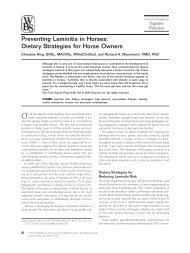Nutritional Secondary Hyperparathyroidism in the Horse
Nutritional Secondary Hyperparathyroidism in the Horse
Nutritional Secondary Hyperparathyroidism in the Horse
You also want an ePaper? Increase the reach of your titles
YUMPU automatically turns print PDFs into web optimized ePapers that Google loves.
Discussion 27<br />
Table VZZ. Nuclear size and cytoplasm/nucleus ratio of parathyroid cells <strong>in</strong> man<br />
and horse<br />
Ma,, <strong>Horse</strong><br />
Nuclear size C/N Nuclear size C/N<br />
planimeter ratio sq. ,LL ratio<br />
units<br />
Dark chief cells 9.9-1 3.5 1.69 10-12 2.5<br />
Light chief cells 13.7-1 7.3 2.44 18.66 5.28<br />
Small water-clear cells 12.7-1 7.1 2.88 -<br />
Large water-clear cells 16.3-21.9 5.76 14.02 7.81<br />
Dark oxyphil cells 11.2-18.0 4.05 -<br />
Pale oxyphil cells 9.2-14.6 8.56 19.71 10<br />
It should be noted that EGER and VAN LESSEN gave <strong>the</strong> size of <strong>the</strong><br />
nuclei <strong>in</strong> planimeter units. Their figures are <strong>the</strong>refore not directly<br />
comparable with those for <strong>the</strong> horse, which are given <strong>in</strong> conventional<br />
measures.<br />
Because of <strong>the</strong> chang<strong>in</strong>g nuclear size and <strong>the</strong> cytoplasm to<br />
nucleus ratio <strong>in</strong> <strong>the</strong> different cells, EGER and VAN LESSEN (1954) felt<br />
that <strong>the</strong> functional capacity <strong>in</strong>creased from <strong>the</strong> rest<strong>in</strong>g dark chief cell<br />
through <strong>the</strong> small water-clear cell and <strong>the</strong>n gradually decreased to no<br />
activity <strong>in</strong> <strong>the</strong> pale oxyphil cell. TRIER (1958), however, showed <strong>in</strong><br />
electron micrographs, that <strong>the</strong> typical granulation of <strong>the</strong> oxyphil cells<br />
was due to accumulations of mitochondria. He thus established that<br />
<strong>the</strong> oxyphil cells are highly active metabolically. He was confirmed <strong>in</strong><br />
1961 by <strong>in</strong>dependent <strong>in</strong>vestigations by BALOGH and COI-IEN and by<br />
TREMBLAY and CARTIER which showed that <strong>the</strong> highest enzymatic<br />
activity was present <strong>in</strong> <strong>the</strong> oxyphil cells.<br />
Although <strong>the</strong> size of <strong>the</strong> cytoplasm and, consequently, <strong>the</strong> cytoplasm<br />
to nucleus ratio of all parathyroid cells are considerably greater<br />
<strong>in</strong> <strong>the</strong> horse than <strong>in</strong> man, <strong>the</strong> t<strong>in</strong>ctorial properties of <strong>the</strong>se cells<br />
justifj <strong>the</strong> use of <strong>the</strong> same nomenclature <strong>in</strong> <strong>the</strong> two species.<br />
It is difficult to make an evaluation of <strong>the</strong> parathyroid activity as a<br />
function of <strong>in</strong>dividual horses, sex, and age from our material. With <strong>the</strong><br />
great variations <strong>in</strong> <strong>the</strong> parenchyma to <strong>in</strong>terstitiurn ratio and with <strong>the</strong><br />
high <strong>in</strong>cidence of embryologic rudiments <strong>in</strong> <strong>the</strong> parathyroids, weight<br />
as such is of little or no importance <strong>in</strong> <strong>the</strong> evaluation of <strong>the</strong> functional<br />
state. The regression l<strong>in</strong>e of <strong>the</strong> relative weight of <strong>the</strong> upper parathyroids<br />
as a function of age showed a slight but <strong>in</strong>significant decrease.<br />
There were no differences between <strong>the</strong> sexes, but <strong>the</strong> variation between<br />
horses was remarkable. The parenchyma to <strong>in</strong>terstitium ratio, <strong>the</strong><br />
3 Krook/Lowe<br />
Downloaded from<br />
vet.sagepub.com by guest on April 14, 2010



